Introduction
It is impossible to ignore the way that the world and society advance quickly in this century. That is the reason why the tactics towards shaping the economy and advertising change by getting new elements. The consequence of the world financial crisis impacts the conventional way to deal with the circle of advertising incredibly. These days, companies need to work on their advertisements to make them more appealing to the target customers (Angel and Sanchez 436). Under these conditions, Saudi Arabia, customarily being taken as reliant on the petroleum-based products, begins to make a few stages with a specific end goal to enhance and locate some other powerful sources of income for the budget. That is the reason why the movement towards a little business can be watched even there. These days, many customers have established an attachment to a particular brand. The loyalty of a customer contributes to the success of the brand (Jackson 13).
Alteration in the marketing mix is a persuasive element that affects the behavior of the consumer. At the point when purchasers visit a franchise shop, the ambiance of the store can impact them. For example, the components such as the smell, music, shading, social settings, and virtual shopping circumstances are likely to influence the consumers. If the store’s physical environment is encompassed with a great atmosphere, the buyers may have a positive bearing, and they will tend to purchase the item from the shop. The consumer’s buying process is influenced by purchase decisions and psychological factors, as shown in Figure 1.1 below.
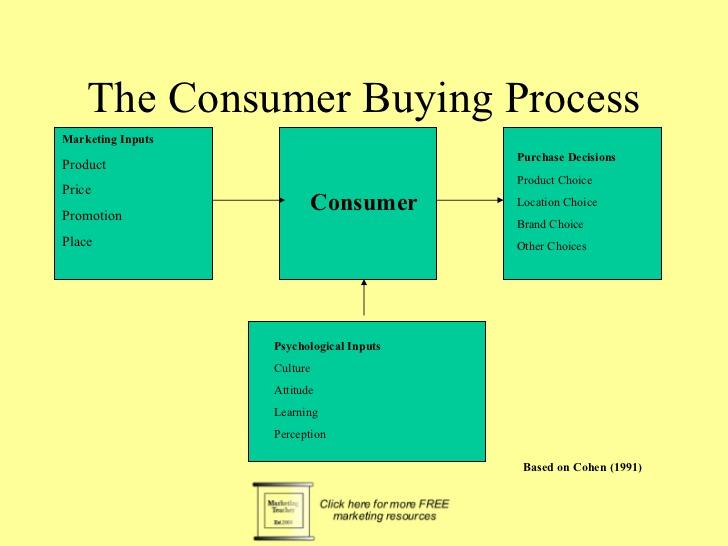
The purchase circumstances can have an unequivocal influence on the purchaser’s responsive state. Additionally, time imperatives can change the purchasers’ examination of information. The buyers tend to settle on straightforward decisions than those in less strained circumstances because of time stress. If customers go shopping just before the shop closes, they do not have sufficient time to ponder and consider the appropriate product. Among the marketing mix elements, price generates revenue to the business, but promotion, place, and product incur costs (Kotler 42).
Franchise business in Saudi Arabia
For the past 20 years, many scholars have explored the issue of franchising business in developing markets. This has prompted the research in franchising business in countries like Mexico and the South American countries, the Asian market (Singapore, Malaysia, Hong Kong, Indonesia), and other parts of the world, such as Kuwait, India, and South Africa. There has been less exploration done about franchising business in the Middle Eastern and North African (MENA) nations, and the Gulf Cooperation Council (GCC) nations, which have encountered franchising for over 30 years (“Saudi Arabia – Marketing and Sales Strategy” par. 3). This is obviously because of the small number of franchise establishments in these nations contrasted with the western countries.
The franchising business changes extensively, starting with one nation then onto the next. Case in point, research directed in the U.S. or different nations cannot be summed up and connected to the MENA countries’ instance because of contrasts in social, monetary, legitimacy, and political perspectives. In this manner, thought should be given to these distinctions when examining the franchising encounters of Arab nations to create speculations that adapt to these parts of the Middle Eastern experience.
More observational research should be led in all parts of franchising in developing markets. The contrasts between these nations and locales ought to be inspected, contemplating the significance by governments in sorting out franchise situations in these business sectors. Although franchising is developing and growing in Saudi Arabia, the business sector stays commanded by a small number of expansive organizations with generally outside brands.
Insights demonstrate that the aggregate number of business enrollments in Saudi Arabia was 854,679, and SMEs represent the massive larger part of them. The SMEs’ franchise business contributes highly to the GDP, even though the standard effect of the non-oil segment of the economy for the last half-decade was 54% (“Saudi Arabia – Marketing and Sales Strategy” par. 3). Likewise, the recent statistics demonstrate that there are only 381 franchise brands in the country when contrasted and the aggregate number of enlisted foundations in the country.
The influence of the environmental factors on the franchise business in Saudi Arabia
The marketing mix, in line with the franchise business in Saudi Arabia, is based on some critical components. These components include the process of the marketing mix and the program. They are important for the standardization of the marketing mix. Figure 1.2 illustrates the important components of the marketing mix.
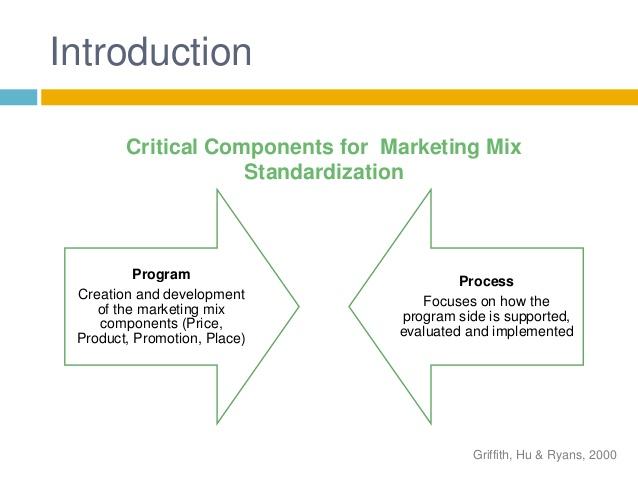
The performance of the franchising business has changed of late, and new patterns have constrained the franchisors to engage in value addition to catch new markets. Some imperative components influencing the franchising business include:
- Rivalry: There is extreme competition among the franchising establishments because new players have emerged within the business sectors. In Saudi Arabia, the pattern has been most seen in the foundation of fast food chains and retail outlets. As the level of competition is getting extreme now and then, the franchisors need to come up with new techniques to keep in front of the contenders.
- Value addition to the services: The exchanges of innovation, specialized expertise, and help have turned into the essential luxuries to be given by the franchisors. The franchisors have included new services like internal correspondence frameworks, programming, and so on, to increase the value and the quality of the services.
- Client Needs: As globalization keeps on demonstrating its significance, the client’s conduct has gotten to be excessively critical. The client has various alternatives, and steadfastness can without much of a stretch be breached. This has prompted the customization of administrations and items as per the requirements of the general population. Franchisee assumes an unmistakable part in it and keeps the franchisor upgraded with client criticism. It is one of the central items influencing the franchising business currently.
- Legal issues: Even though the legal issues’ impacts are minimal, it might still be noteworthy if the laws relating to the ownership and management or any part of the franchising business set up.
Market Mix in Saudi Arabia and consumer perception about its alteration
There are distinctive elements that impact the customers’ perception regarding the alteration of the marketing mix. Nature and the feel of the franchise assume a major part in affecting the consumers’ choices. The choices of the customers are impacted, for the most part, by the image of the franchise and what other individuals say in regards to the franchise. Furthermore, the more established consumers like to do their shopping in calm spots with a decent feeling and delicious nourishments. More youthful individuals have developed an attachment and a sense of loyalty to a particular franchise that offers them the required satisfaction (Chaudhuri and Holbrook 87). This critical issue has initially been underestimated inside of the field of franchising, together with the lack of franchising examination in the Middle East.
The franchise completely fulfills many clients if the costs are reasonable, and the service quality is great. The clients will have a justifiable motivation to return to the shop and even prescribe the shop to a companion. The impact of others likewise influences the customer’s process of decision-making. A client can choose to pick a specific shop or franchise outlet because his/her companions typically visit. The clients typically have a propensity for trading thoughts with their companions in regards to new outlets that have come up keeping in mind the end goal to get their recommendation. At the point when an outlet is respected exceedingly by companions, the client is well on the way to lean toward it. Publicizing likewise impacts the perception of the clients.
Literature review
Consumer perception is the study of how, when, why, and where people do or do not source for goods or services. It attempts to assess the clients’ influence from external factors such as high salaries and income and the growth of urban lifestyle, among others. It is a common practice for customers to purchase goods and services for several reasons. These reasons may include reinforcing self-concepts, maintaining a given lifestyle, becoming part of a particular group, or gaining acceptance in a group they already belong, and or expressing cultural identity. Many researchers have used a representative sample to examine consumers’ perceptions regarding the alteration in the marketing mix (Cooper and Schindler 105).
Even though the purchase circumstance pushes the shoppers to purchase the item, the mental variables apply when the customers pick a brand of the item. Psychological motives are classified into many categories. Two criteria determine the four major categories, for instance, whether the mode of actions is cognitive or effective, and whether the motive is centered on the preservation or growth. The four major categories are further subdivided into two groups: whether the deeds of the consumer have been initiated or are a response; and whether the conduct of the consumer occurs internally or externally.
The study of customer conduct is relevant to the modern business world as it speaks volumes on the customers’ decision-making (Malhotra, Marketing research 134). The cognitive motives include cognitive preservation motives and cognitive growth motives. The cognitive preservation motives include the need for uniformity, which occurs internally and actively.
A consumer is somebody who has purchased an item or service of an organization, vendor, or supplier. Be that as it may, from the perspective of consumer loyalty, the client’s clarification should include the individual who uses administrations from the organization specifically or by implication. That is more inclined to assume anyone who may purchase any item or service to be a client. The organization needs an activity to convey their items to clients; this sort of activity is generally called a service.
Customer service has numerous sorts; they are taking into account the kind of item and associations. In diverse spaces, the service can be characterized in various examples. The consumer behavior can be illustrated by a model that consists of personal characteristics, environmental characteristics, stimuli, decisions, and the vendors’ controlled systems. The model is illustrated in Figure 2.1 below.
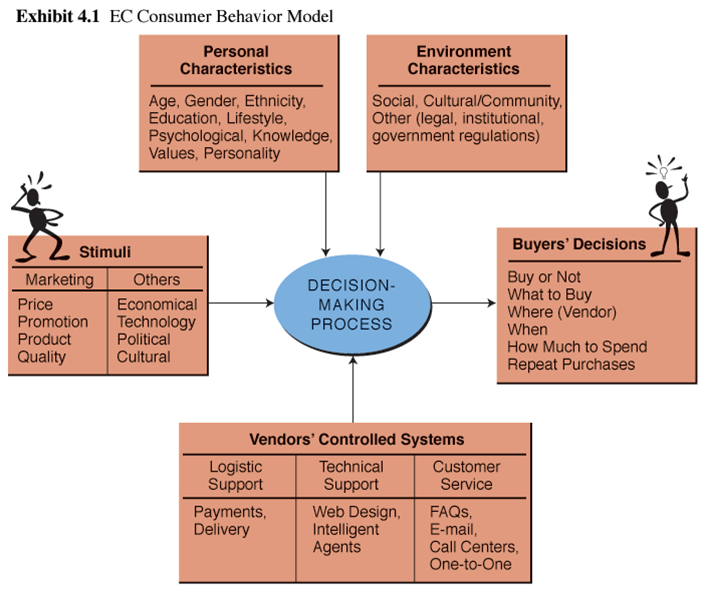
Many researchers have used different methodologies to explore the marketing mix concept and how the elements relate to each other (Burns and Bush 106). The primary advantage of this way to deal with interchanges is that it furnishes the publicist with complete control of what message and feeling to bestow into the promotion. Any brand can powerfully advance its advantages to purchasers and endeavor at drawing in them with a message of useful and enthusiastic qualities, to expand brand/item thought and deals.
As a consequence of good purchaser and contender knowledge, brands can make promoting, which displays them in the best conceivable light, to engage potential clients. Media stations, techniques, and innovative yield are all measured and are chosen by the brand/organization, making the outcome useful much of the time. This has a big impact on consumers’ loyalty to a brand (Angel and Sanchez 436).
Keeping in mind the end goal to survey the suitability of distinctive sorts of promotion to the franchise business in Saudi Arabia, a more intensive examination of the conduct of the intended interest group needs to be taken. The franchise business sector’s new targets are 30-50-year-old, upper-middle-class people with substantial work timetables, and minimal leisure time. People conveying these attributes would invest most of their energy outside of the home, and could accordingly be seen as prime time TV watchers. Radio promotion may be seen as less appealing a possibility for various reasons. The customer’s loyalty is tied to a product because of the advertising experience (Jackson 14).
Firstly, the new targets are Riyadh-based people, which imply that a substantial number of this gathering would, in all probability, be general workers, and would not be utilizing an individual engine vehicle regularly. This, thus, implies that they fall outside of the typical radio promotion target group. Besides, radio publicizing, despite being a less expensive mass reputation alternative, is viewed as outdated and obsolete, which is the reason it would not resound with the sector’s more advanced, computerized picture. Print publicizing may be especially fit for the online retailer’s new campaign as it considers the focusing of workers.
Likewise, it can convey messages capably through the great nature of imaginative work. Print publicizing is an extremely regular segment of the incorporated promoting specialized tool. It has a high crowd achieve and can be a good avenue for delivering essential communication and enhancing the loyalty of the customers. This has a lasting effect on consumer perception and loyalty (Angel and Sanchez, 437).
Hypotheses
Having illustrated the primary propensities impossible to miss the economy of Saudi Arabia these days, it is conceivable to diagram the fundamental targets and objectives of the given study. Subsequently, the assessment of the buyer observation about an adjustment in advertising blend and examination of the established business and its eccentricities in Saudi Arabia could be taken as the fundamental objectives of the given paper. Additionally, four classifications that contain the market mix ought to likewise be broken down. They are product, price, promotion, and place. Furthermore, the following hypothesis will be used
- H1. The changes in the attitude towards franchises could be observed due to the world market’s main tendencies.
- H2. Market Mixs alteration influences the change in consumer perception.
Among the variables related to the tendencies of the world market and marketing mix of product, price, place, and promotion include functional diversity, deep level diversity, mutual trust, knowledge sharing, communication quality, and cultural diversion. All these elements are related to the alteration of the marketing mix.
Methodology
The methodology is the process of instructing the ways to do the research. Therefore, it is convenient for conducting research and analyzing the research questions (Zikmund 57). This part includes the research design, the sample, and the methods used in gathering information. It also contains the data analysis methods, validity and reliability of data, and the study’s limitation. Considering the principle point of the given paper, it is conceivable to say that the review of which the fundamental point is to gather the information associated with the state of mind towards the movement of needs towards the little business and franchising ought to be led.
Number of samples
The study used a sample of 208 respondents who all took part in the study. Their responses were recorded through a questionnaire. Questionnaires are pre-formulated questions which capture the overall objectives of the study (Sekaran 102)
Research environment
The environment in which the data was collected was in Saudi Arabia. This was in line with the main objective of the study on the consumers’ perception of the alteration of the marketing mix.
Limitations
The cost of conducting the survey was expensive. Also, there were instances when the respondents provided false and incorrect responses. The process of data collection was time-consuming and tedious. Also, a couple of respondents were reluctant to offer some information that was private and hazardous in the hands of their opponents. This meant a phenomenal test in the examination as the researcher expected to take more opportunity to find respondents who might enthusiastically give out adequate information.
Results
Table 4.1 shows the summary of the demographical attribute of the respondents who took part in the study.
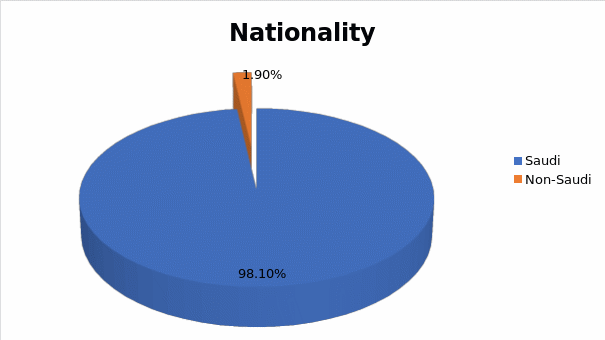
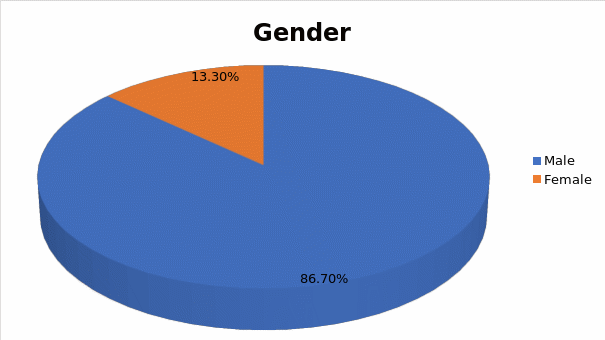
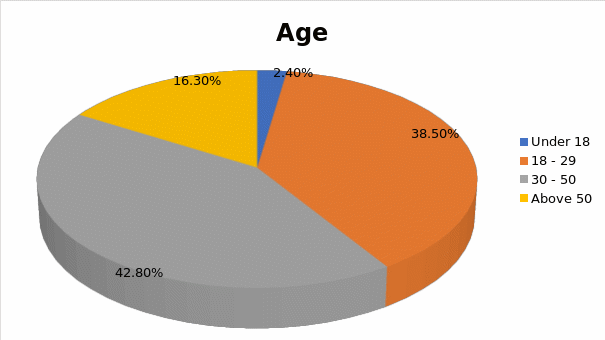
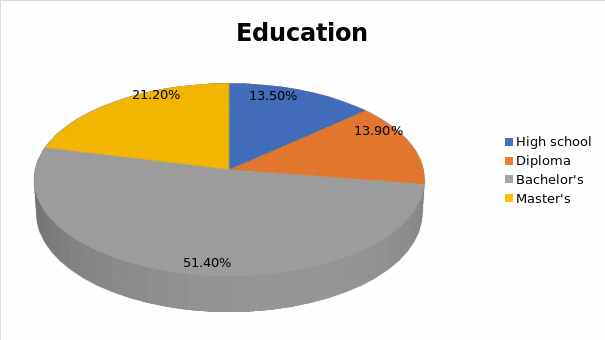

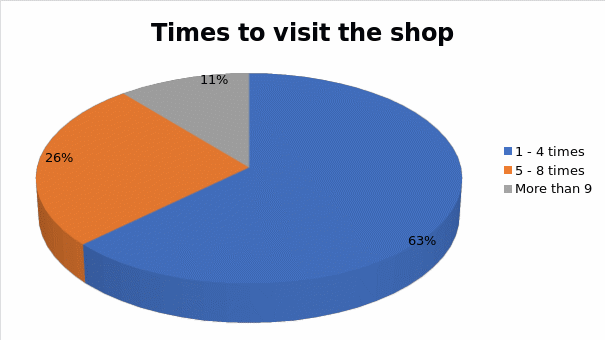
Reliability Analysis
Reliability analysis is often used to evaluate whether the multiple instrument items are measuring the same variable or concept. In SPSS, the Cronbach’s Alpha value is normally used to measure the various variables. The minimum requirement for the value of Cronbach’s Alpha is 0.7 to ensure that the items are internally consistent and reliable. In the exploratory study, the Cronbach’s Alpha value of 0.6 can also be accepted. In this study, the various measurement items are adopted from previous studies. Thus, the minimum value is set at 0.7. The corrected-item total correlation (CITC) is also included to evaluate the reliability of the individual item. If the CICT is below 0.5, then the item cannot reliably measure the corresponding variable and should be excluded from further analysis.
Table 4.2 Reliability Analysis for Variables.
According to the results, the Cronbach’s alpha value of the Functional diversity, deep level diversity, mutual trust, knowledge sharing, communication quality, cultural adaption, and consumer perception are 0.836, 0.817, 0.761, 0.739, 0.898, 0.833, and 0.837, which are all above the minimum requirement of 0.7. Also, the CICT for individual items is all above the minimum requirement of 0.5, and the Cronbach’s Alpha, if deleted for individual items, are all below the Cronbach’s Alpha value. These results demonstrate that these items are internally consistent and reliable, and can be used for further analysis.
Regression analysis
Regression analysis is a statistical process for estimating the relationships among variables. More specifically, regression analysis is normally used to understand how the change of independent variables can affect the change of dependent variables. The correlation analysis above indicated that there are relationships between cultural adaption, communication quality, Functional diversity, mutual trust, knowledge sharing, deep level diversity, and virtual team effectiveness. To find out how these variables influence customer perception and which one has the biggest impact, the multiple linear regression is used.
Table 4.3 Model Summary.
The Adjusted R Square is 0.538, which means that the independent variables of cultural adaption, communication quality, Functional diversity, mutual trust, knowledge sharing, and deep-level diversity can explain 53.6% of the variance of the virtual team effectiveness.
Table 4.4 ANOVA.
By summarizing the ANOVA table, it can be said that the independent variables of cultural adaption, communication quality, Functional diversity, mutual trust, knowledge sharing, and deep-level diversity can predict the dependent variable of consumer perception at a significance of 0.01, by considering F=411.961.
Table 4.5 Coefficients.
The regression results are summarized in Table 4.4 above. According to the results, there is no collinearity problem among the independent variables. The VIF values for all independent variables are less than ten, and the tolerance value for all variables is above 0.1. It is found that cultural adaption, communication quality, functional diversity, mutual trust, knowledge sharing, and deep-level diversity can significantly impact consumer perceptions, with sig values all less than 0.05. Specifically, cultural adaption has the biggest impact on virtual team effectiveness. It has a standardized coefficient value of 0.437, followed by a communication quality, with a standardized coefficient value of 0.424 and mutual trust, with a value of 0.334. The deep-level diversity has the smallest impact on virtual team effectiveness, with a standardized coefficient value of 0.212.
Discussion
Consumers make their decisions based on the available time. Business chiefs are endeavoring to set up and keep up an environment that is greater for the fulfillment of consumers, who are endeavoring together in groups towards the achievement of foreordained objectives. A few studies have been completed to scout the examples of the conduct of the consumers. The consumers’ profiles are different as to their likelihood to shop at merchandising channels, their decision of shopping centers, and their wellsprings of data concerning the accessible shopping exercises.
The culture of a society can influence the consumer to try new goods and services. The marketing mix elements like product, place, promotion, and price impact the consumer conception because individuals expect to identify with a particular group. The family can assume the solid part of affecting buyer conduct because they may share their contemplations and proposals that rouse their relatives to purchase the specific item. Their positive convictions towards a product’s brand provoke the consumer to purchase a product.
Conclusion
Alteration in the marketing mix is an important element that influences the sensitivity of the consumers. Immediately a customer decides to visit a franchise shop; the environment of the store can have an impression on them. For instance, elements such as the smell, music, shading, social settings, and virtual shopping circumstances are likely to impact the consumers. If the store’s physical environment is encompassed with a great atmosphere, the buyers may have a positive bearing, and they will tend to purchase the item from the franchise store.
The primary ideas of the thought of the marketing mix could likewise be connected to the circumstance in Saudi Arabia. The adjustment of some customary examples exceptional to the economy of a state implies likewise the change of the classifications, which involve the given advertising device.
In this way, it is evident that under current conditions, such classes as product, price, promotion, and place get new significance affected by an incredible number of outside variables. That is the reason; it is also basic to consider that the consumer perception could be influenced by the arrangement of variables that advance a specific improvement of the circumstance impossible to miss to Saudi Arabia.
Works cited
Angel, Villarejo and Manuel Sanchez. “The impact of marketing communication and price promotion on brand equity”. Brand Management 12:6 (2005): 431-444. Print.
Burns, Alvin and RF. Bush. Marketing research, New Jersey: Pearson Education, 2006. Print.
Chaudhuri, Arjun and Morris Holbrook. “The chain of effects from brand trust and brand affect to brand performance: The role of brand loyalty”. Journal of Marketing 65:2 (2001): 81-93. Print.
Cooper, Donald and PS. Schindler. Business research methods, New York: McGraw Hill, 2006. Print.
Jackson, Robert. “A lighter wallet due to loyalty: the influence of brand loyalty on the amount a consumer is willing to pay for their preferred brand”. Journal of Psychology 1:1 (2010): 12-15. Print.
Kotler, Philip. Marketing insights from A to Z, Melbourne, Canada: John Wiley and Sons, 2003. Print.
Malhotra, Naresh. Marketing research: An applied orientation, New York, Pearson Education, 2004. Print.
Malhotra, Naresh. Basic marketing research, New York, Pearson Education, 2005. Print.
Sekaran, Uma. Research methods for business: A skill building approach, New York, John Wiley and Sons, 2003. Print.
Saudi Arabia – Marketing and Sales Strategy 2015. Web.
Zikmund, William. Business research methods, New York, Thomson South Western, 2003. Print.